Fireweed Metals Corp. report the final results from the 2023 drilling campaign at its Tom and Jason deposits, Macmillan Pass (“Macpass”) Project, Yukon, Canada.
Highlights
- Hole TS23-009 intersected 17.95 m (est. 14 m true width) of 11.45% zinc, 5.86% lead and 126.3 g/t silver, including 6.6 m of 19.33% zinc, 8.42% lead, and 225.1 g/t silver.
- Hole TS23-009D2 intersected 18.78 m (est. 9.8 m true width) of 9.82% zinc, 11.65% lead, and 180.1 g/t silver, including 11.75 m of 11.93% zinc, 16.17% lead, and 260.5 g/t silver.
- Both TS23-009 and TS23-009D2 intersected the new Tom South zone which was not in the 2018 mineral resource. There is substantial potential in this zone beyond what was intersected this year.
- Drill results are now fully disclosed for the 2023 drilling campaign at Macpass.
CEO Statement
Brandon Macdonald, CEO, stated, “The intersection of continuous high-grade feeder style mineralization at Tom South is arguably one of the most significant discoveries at this deposit in decades and is a >100-metre step-out beyond the known Tom resource. These intercepts provide a tantalizing glimpse that Tom Southeast and Tom West may form a continuous zone of stratiform and massive sulphide mineralization connected around a fold hinge at Tom South. We are excited at the prospect of exploring this concept in 2024 and are reminded that despite generations of work, the Tom and Jason deposits may still have surprises in store for us.”
Summary
The mineralization from drill holes in this release primarily comprise stratiform (layer-parallel) and massive (>50% sulphides) sulphides in Tom West, Tom South and Jason South. At Tom West and Tom South this mineralization forms a continuous steeply dipping domain with sharp margins, occurring from surface to at least a depth of 750 m and across a strike length of 1,500 m. At Jason South, mineralization occurs as a series of steeply dipping stratiform lenses from 250 m below surface to a depth of at least 730 m and a strike length of 450 m. The intersections in holes TS23-009, TS23-009D1, and TS23-009D2 represent a significant 100 m step out from mineralization included in the current Tom resource and comprise high-grade massive sulphides associated with feeder style mineralization.
Results
The drill holes in this release are located at Tom West, Tom South, and Jason South and targeted stratiform and massive sulphides with a focus on step outs from the current mineral resource that was last updated in 2018. Holes TS23-009, TS23-009D1, and TS23-009D2 stepped out from an isolated intersection in historical hole TS90-012 which was not included in the 2018 resource. All three holes intersected high-grade stratiform and massive sulphides, which support the idea there is a continuous domain of mineralization outside of the 2018 resource that remains open along strike. Holes TS23-001 to TS23-008 intersected stratiform zinc mineralization, successfully stepping-out downdip and northwest from the known mineral resource at Tom West.
Table 1: Assay highlights for 2023 holes at Tom and Jason.
| Drillhole | Interval | From (m) | To (m) | Interval Width (m) | Est. True Width (m) † | Zinc (%) | Lead (%) | Silver (g/t) | Bulk Density (t/m3) |
| TS23-003 | Primary | 250.80 | 280.50 | 29.7 | 22 | 3.59 | 0.31 | 1.5 | 2.84 |
| TS23-003 | Including | 261.75 | 271.00 | 9.25 | 6.9 | 6.24 | 0.54 | 1.8 | 2.94 |
| TS23-009 | Primary* | 719.00 | 736.95 | 17.95 | 14 | 11.45 | 5.86 | 126.3 | 3.04 |
| TS23-009 | Including* | 723.60 | 730.20 | 6.6 | 5.1 | 19.33 | 8.42 | 225.1 | 3.23 |
| TS23-009D1 | Primary | 715.74 | 736.44 | 20.7 | 20 | 4.83 | 3.32 | 52.4 | 2.87 |
| TS23-009D1 | Including | 728.61 | 736.44 | 7.83 | 7.7 | 10.63 | 7.08 | 112.2 | 3.08 |
| TS23-009D1 | >Including | 729.61 | 736.44 | 6.83 | 6.7 | 11.70 | 7.89 | 123.7 | 3.12 |
| TS23-009D2 | Primary | 794.20 | 812.98 | 18.78 | 9.8 | 9.82 | 11.65 | 180.1 | 3.39 |
| TS23-009D2 | Including | 796.45 | 811.57 | 15.12 | 7.9 | 10.95 | 13.53 | 211.3 | 3.51 |
| TS23-009D2 | >Including | 799.82 | 811.57 | 11.75 | 6.1 | 11.93 | 16.17 | 260.5 | 3.66 |
| JS23-001D1 | Primary | 595.98 | 621.55 | 25.57 | Unknown | 3.75 | 2.50 | 30.7 | 3.13 |
| JS23-001D1 | Including | 595.98 | 612.95 | 16.97 | Unknown | 4.18 | 2.98 | 39.3 | 3.16 |
† See “Data Verification” for a description of true width calculations
At the Tom deposit, mineralization is contained within tabular zones, that dip outwards around the margins of a doubly-plunging, kilometre-scale anticline fold. The deposit is subdivided into several zones, Tom West (or Tom Main zone), Tom East, and Tom Southeast. Tom North was drilled and re-discovered in 2019, interpreted as a northern extension of Tom West that is not included in the current mineral resource (see Fireweed news release dated August 20, 2019). New drilling at Tom South indicates it is a southern extension of Tom West on the nose of an anticline fold. 2023 drilling tested Tom South with hole TS23-009 and two directional-splay holes TS23-009D1 and TS23-009D2. Mineralization at Tom is subdivided into geological domains, based on mineralogy and texture: massive sulphide, and pink facies, grey facies, and black facies based on the colour of the sphalerite (zinc) mineralization. Examples of the high-grade massive to laminated sulphides encountered at Tom South, and the black-facies and grey-facies mineralization within hole from Tom West can be seen in Photos 1 to 3. Assays have now been received for all 2023 Tom and Jason holes (Tables 1 and 3). Summaries for new drill results reported in this news release are as follows:
- Hole TS23-009 intersected 17.95 m (14 m est. true width) of massive and stratiform sulphide grading 11.45% zinc, 5.86% lead, and 126.3 g/t silver, including 6.60 m grading 19.33% zinc, 8.42% lead, and 225.1 g/t silver. Recovery in this mineralized intercept was 64%—below the recovery threshold of 85% typically deemed acceptable at the project, and as a result a secondary hole was drilled as TS23-009D1.
- Hole TS23-009D2 intersected 18.78 m (est. true width 9.8 m) of massive and stratiform sulphide grading 9.82% zinc. 11.65% lead and 180.1 g/t silver, including 11.75 m grading 11.93% zinc, 16.17% lead, and 260.5 g/t silver.
- Hole TS23-009D1 intersected 20.70 m (est. true width of 20 m) of massive and stratiform sulphide grading 4.83% zinc, 3.32% lead, and 52.4 g/t silver, including 7.83 m grading 10.63% zinc, 7.08% lead, and 112.2 g/t silver.
- Hole JS23-001D1 intersected 25.57 m grading 3.75% zinc. 2.50% lead, and 30.7 g/t silver, including 16.97 m grading 4.18% zinc, 2.98% lead, and 39.3 g/t silver.
- Hole TS23-007 intersected 31.58 m (est. true width 19 m) of stratiform sulphide grading 4.49% zinc and 0.53% lead.
- Hole TS23-006 intersected 24.47 m (est. true width 21 m) of stratiform sulphide grading 4.16% zinc, 2.00% lead and 6.2 g/t silver.
- Hole TS23-003 intersected 29.7 m (est. true width 22 m) of stratiform mineralization grading 3.59% zinc and 0.31% lead, including 9.25 m grading 6.24% zinc and 0.54% lead.
- Hole TS23-008 intersected 22.10 m (est. true width 19 m) of stratiform mineralization grading 2.86% zinc and 0.12% lead.
- Hole TS23-005 intersected 17.12 m (est. true width 16 m) of stratiform mineralization grading 3.72% zinc.
- Hole TS23-004 intersected 11.76 m (est. true width 8.7 m) of stratiform mineralization grading 3.33% zinc, 0.32% lead and 1.5 g/t silver.
- Hole JS23-001 intersected 2.02 m of stratiform mineralization grading 8.69% zinc and 3.6 g/t silver.
- Hole TS23-002 intersected 3.06 m grading 6.34% zinc, 0.98% lead, and 8.5 g/t silver.
- Hole TS23-001 intersected 0.6 m grading 3.8% zinc.
See Tables 1, 3, 4, and 5, Cross Sections TA–TA’, TB–TB’, TC–TC’, TD–TD’, TE–TE’, TF–TF’, JA–JA’, Long Section TG–TG’, and Maps 2, 3, 4, and 5 below for further details.
2023 Prospecting Program
Fireweed conducted a short prospecting program at Macpass in 2023, focusing around geochemical and geophysical anomalies that could be related to reduced intrusion related gold systems. Prospecting crews took 535 rock samples, with gold grades between 1 and 3,121 parts-per-billion (ppb) gold. Results over 100 ppb gold (12 samples) are presented in Table 2. Evidence of arsenic-bismuth bearing ~NW-SE trending and NE dipping veins with generally low and spotty gold values was located within hornfels rock at the newly defined Neptune showing, interpreted as distal alteration around a Mid-Cretaceous buried reduced intrusion. The depth to the hypothesized intrusion cannot be accurately estimated with the current observations and more work is required to accurately assess the potential at Neptune.
Fireweed intends to continue prospecting in the upcoming 2024 field season, with an emphasis on following up anomalies in a commodity agnostic manner, using a data-driven approach. Fireweed owns almost 1,000 square kilometres of mineral tenure within the Selwyn basin, one of the world’s most significant basins for zinc mineralization, where Fireweed sees great potential for additional zinc discoveries. Fireweed’s ground is also within the Mayo-Tombstone-Tungsten belt of intrusive rocks that on Fireweed’s claims, host the world’s largest high-grade tungsten deposit**, Mactung, and off Fireweed’s claims, also includes the past-producing Cantung tungsten mine, and emerging gold discoveries.
Table 2: Rock samples over 100 ppb gold from the 2023 prospecting program
| Sample | Au (ppb) | Ag (ppm) | As (ppm) | Bi (ppm) | Te (ppm) |
| 4303342 | 3173 | 4.65 | 79107 | 259.5 | 0.5 |
| 4303156 | 1174.6 | 2.97 | 89178 | 73.3 | N/A |
| 4303283 | 737.5 | 9.1 | >100000 | 88.6 | 0.3 |
| 4303438 | 725 | 5.5 | >100000 | 58.5 | 1.0 |
| 4303437 | 620 | 9.37 | >100000 | 30.5 | 2.0 |
| 4303231 | 338.3 | 1.225 | 20870 | 10.5 | 12.0 |
| 4303420 | 276.5 | 6.4 | 26559 | 0.3 | 0.5 |
| C0042653 | 251.5 | 4.35 | 1375 | 7.7 | 0.5 |
| 4303344 | 232 | 1.4 | 97909 | 17 | 0.5 |
| 4303202 | 165 | 17.47 | 241 | 0.9 | N/A |
| 4303345 | 131.5 | 1.2 | 59373 | 21.4 | 1.3 |
| 4303311 | 109.5 | 2.63 | 308 | 1.2 | 0.5 |
About Fireweed Metals Corp. (TSXV: FWZ; OTCQB: FWEDF; FSE:M0G): Fireweed Metals is a public mineral exploration company on the leading edge of Critical Minerals project development. Fireweed is well-funded, with a healthy balance sheet, and has three projects located in Canada:
- Macpass Project (Zinc-Lead-Silver): Fireweed owns 100% of the district-scale 940 km2 Macmillan Pass (“Macpass”) Project in Yukon, Canada, which is host to one of Earth’s largest undeveloped resources of zinc**, a Critical Mineral. The Tom and Jason zinc-lead-silver deposits have current Mineral Resources1 (11.21 Mt Indicated Resource at 6.59% zinc, 2.48% lead, and 21.33 g/t silver; and 39.47 Mt Inferred Resource at 5.84% zinc, 3.14% lead, and 38.15 g/t silver) and a Preliminary Economic Assessment2 (PEA). In addition, Boundary Zone, Tom North, Tom South, and End Zone have significant zinc-lead-silver mineralization drilled but not yet classified as mineral resources. The Project also includes large blocks of adjacent claims with known showings and significant upside exploration potential.
- Mactung Project (Tungsten): The Company owns 100% interest in the 37.6 km2 Mactung Project located adjacent to the Macpass Project. Recently announced Mineral Resources for Mactung (41.5 Mt Indicated Resource at 0.73% WO3 and 12.2 Mt Inferred Resource at 0.59% WO3)3 make it the world’s largest high-grade resource of the Critical Mineral tungsten**. Located in Canada, it is one of the rare large tungsten resources outside of China**.
- Gayna Project (Zinc-Lead-Gallium-Germanium): Fireweed owns 100% of the 128.75 km2 Gayna Project located 180 km north of the Macpass Project. It is host to extensive mineralization including Critical Minerals zinc, gallium and germanium as well as lead and silver, outlined by 28,000 m of historical drilling. A recent reevaluation of the geology supported by recent ground gravity geophysics results, soil surveys, and high grade rock samples, indicate drill targets with potential for high-grade Kipushi-style massive sulphide mineralization.
Qualified Person Statement
Technical information in this news release has been approved by Fireweed’s Senior Geologist, Ian Carr, P.Geo. (BC), a ‘Qualified Person’ as defined under Canadian National Instrument 43-101.
In Canada, Fireweed (TSXV: FWZ) trades on the TSX Venture Exchange. In the USA, Fireweed (OTCQB: FWEDF) trades on the OTCQB Venture Market (www.otcmarkets.com) and is DTC eligible for enhanced electronic clearing and settlement. In Europe, Fireweed (FSE: M0G) trades on the Frankfurt Stock Exchange.
Additional information about Fireweed and its projects can be found on the Company’s website at FireweedMetals.com and at www.sedarplus.com
ON BEHALF OF FIREWEED METALS CORP.
“Brandon Macdonald”
CEO & Director
Neither the TSX Venture Exchange nor its Regulation Services Provider (as that term is defined in the policies of the TSX Venture Exchange) accepts responsibility for the adequacy or accuracy of this release.
Data Verification
The diamond drill core logging and sampling program was carried out under a rigorous quality assurance / quality control program using industry best practices. Drill intersections in this release are NQ2 size core (50.5 mm/ 1.99-inch diameter) with recoveries typically above 85% unless otherwise noted in the results tables. After drilling, core was cleaned, logged for geology, structure, and geotechnical characteristics, then marked for sampling and photographed on site. Certain cores were selected for core scanning. The cores for analyses were marked for sampling based on geological intervals with individual samples 2 m or less in length, with 1 m samples within mineralized zones. Drill core was cut lengthwise in half with a core saw; half-core was sent for assays reported in this news release, and the other half is stored on site for reference. Bulk density was determined on site for the entire length of each assay sample by measurement of mass in air and mass in water. Sample duplicate bulk density determinations and in-house bulk density standard determinations were each made at a rate of 5%. Since 2017, four in-house bulk density standards (mineralized drill core from the Tom deposit that span a range of densities) have been used and show an acceptable long-term precision. Certified standard masses are used to calibrate the scale balance used for bulk density determinations.
A total of 5% assay standards or blanks and 5% core duplicates are included in the sample stream as a quality control measure and are reviewed after analyses are received. Standards and blanks in 2023 drill results to date have been approved as acceptable. Duplicate data add to the long-term estimates of precision for assay data on the project and precision for drill results reported is deemed to be within acceptable levels. Samples were sent to the Bureau Veritas (BV) preparation laboratory in Whitehorse, Yukon, where the samples were crushed and a 500 g split was sent to the BV laboratory in Vancouver, B.C to be pulverized to 85% passing 200 mesh size pulps. Clean crush material was passed through the crusher and clean silica was pulverized between each sample. The pulps were analyzed by 1:1:1 Aqua Regia digestion followed by Inductively Coupled Plasma Mass Spectrometry (ICP-ES/ICP-MS) multi-element analyses (BV Code AQ270). All samples were also analyzed for multiple elements by lithium borate fusion and X-ray fluorescence analysis (XRF) finish (BV Code LF725). Over-limit lead (>25.0%) and zinc (>24.0%) were analyzed by lithium borate fusion with XRF finish (BV Code LF726). For BV samples, silver is reported in this news release by method AQ270, and zinc and lead are reported by LF725 or LF726. Bureau Veritas (Vancouver) is an independent, international ISO/IEC 17025:2017 accredited laboratory.
Surface samples from the gold program described in this release were submitted with 5% standards or blanks and 2% duplicates that were reviewed after receipt of assays and approved as acceptable. Samples were sent to the BV preparation laboratory in Whitehorse, Yukon, and prepared using the same crushing and pulverizing methods as drill core samples. The resulting pulps were analyzed by 1:1:1 Aqua Regia digestion followed by Inductively Coupled Plasma Mass Spectrometry (ICP-ES/ICP-MS) multi-element analyses (BV Code AQ270). Gold values were determined by lead collection fire assay fusion followed by ICP-ES analysis (BV Code FA330). Any rock sample that initially assayed greater than 0.1 ppm gold was re-assayed from both pulps and coarse rejects and results were found to be repeatable, with variations within the range expected given the nature of the duplicate samples. Reported values for rock samples in Table 2 constitute a mean between initial and re-assayed values for all reported analytes excepting Te, which was only reported in the reanalysis.
Assay values may appear rounded to one decimal place but are given in full in Table 1, Table 2, and Table 3, and Cross Sections where zinc and lead grades are reported to two decimal places.
Drilling results in this news release are length and bulk-density weighted averages as would be used in a Mineral Resource estimate. Length and bulk-density weighted averages have been reported as these most accurately represent the average metal-content of the intersections.
True widths for primary intervals are estimated by measuring perpendicular to strike within the short axis of a stratiform wireframe that has been constructed in 3D around the mineralized intercepts at Tom based on assay results, geological logging, stratigraphic correlation, and bedding measurements from oriented core. The mineralization at Tom is stratiform (oriented parallel to bedding), therefore the true width, or thickness, of the zone is estimated perpendicular to both the strike and dip direction of bedding. True widths are rounded to the nearest metre for widths over 10 m and to the nearest 0.1 m for widths less than 10 m, as this better reflects the precision of the estimates. True widths should be regarded as approximate as these are derived from an estimation that uses a preliminary interpretation of the geological model. True widths for nested intervals (marked as “Including” in results tables) are estimated using a ratio of included to primary intersected widths to attribute appropriate portions of the true width of the primary interval to the nested intervals.
Cautionary Statements
Forward Looking Statements
This news release contains “forward-looking” statements and information (“forward-looking statements”). All statements, other than statements of historical facts, included herein, including, without limitation, statements relating to interpretation of drill results and projections of mineralization, future work plans, the use of funds, and the potential of the Company’s projects, are forward looking statements. Forward-looking statements are frequently, but not always, identified by words such as “expects”, “anticipates”, “believes”, “intends”, “estimates”, “potential”, “possible”, and similar expressions, or statements that events, conditions, or results “will”, “may”, “could”, or “should” occur or be achieved. Forward-looking statements are based on the beliefs of Company management, as well as assumptions made by and information currently available to Company management and reflect the beliefs, opinions, and projections on the date the statements are made. Forward-looking statements involve various risks and uncertainties and accordingly, readers are advised not to place undue reliance on forward-looking statements. There can be no assurance that such statements will prove to be accurate, and actual results and future events could differ materially from those anticipated in such statements. Important factors that could cause actual results to differ materially from the Company’s expectations include but are not limited to, exploration and development risks, unanticipated reclamation expenses, expenditure and financing requirements, general economic conditions, changes in financial markets, the ability to properly and efficiently staff the Company’s operations, the sufficiency of working capital and funding for continued operations, title matters, First Nations relations, operating hazards, political and economic factors, competitive factors, metal prices, relationships with vendors and strategic partners, governmental regulations and oversight, permitting, seasonality and weather, technological change, industry practices, uncertainties involved in the interpretation of drilling results and laboratory tests, and one-time events. The Company assumes no obligation to update forward‐looking statements or beliefs, opinions, projections or other factors, except as required by law.
Footnotes and References
** References to relative size and grade of the Mactung resources and Macpass resources in comparison to other tungsten and zinc deposits elsewhere in the world, respectively, are based on review of the Standard & Poor’s Global Market Intelligence Capital IQ database.
1: For details, see https://www.sedarplus.ca/ Fireweed Technical Report titled “NI 43-101 Technical Report on the Macmillan Pass Zinc-Lead-Silver Project, Watson Lake and Mayo Mining Districts Yukon Territory, Canada” filed on https://www.sedarplus.ca/ on February 23, 2018, and Fireweed News Release dated January 10, 2018.
2: For details, see https://www.sedarplus.ca/ Fireweed Technical Report titled “NI 43-101 Technical Report Macmillan Pass Project Yukon Territory Canada” filed on https://www.sedarplus.ca/ on July 9, 2018, and Fireweed News Release dated May 23, 2018. This Technical Report includes a Preliminary Economic Analysis disclosing an economic analysis of mineral resources that is preliminary in nature and does not include any mineral reserves. It is equally emphasized that the mineral resources disclosed within this Technical Report are not mineral reserves and do not have demonstrated economic viability.
3: For details, see Fireweed news release dated June 13, 2023 “Fireweed Metals Announces Mineral Resources for the Mactung Project: the Largest High-Grade Tungsten Deposit in the World” and the technical report entitled “NI 43-101 Technical Report, Mactung Project, Yukon Territory, Canada,” with effective date July 28, 2023 filed on https://www.sedarplus.ca/


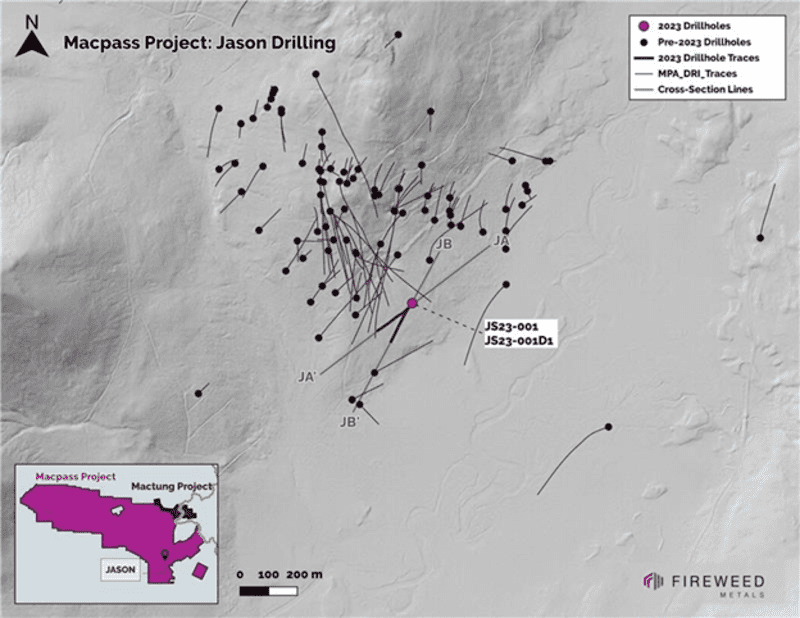
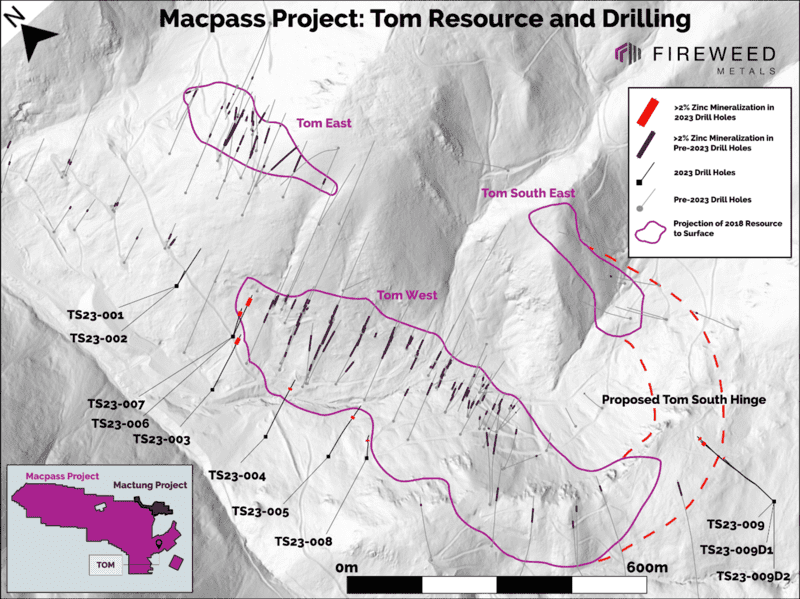
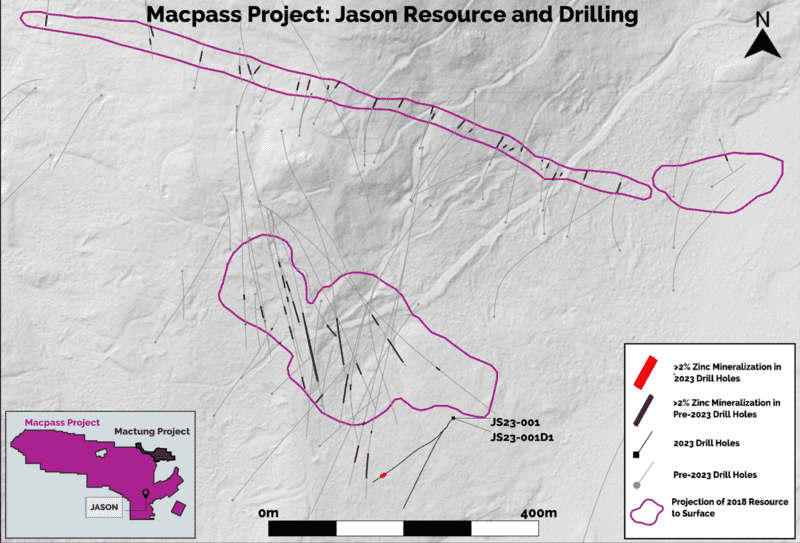
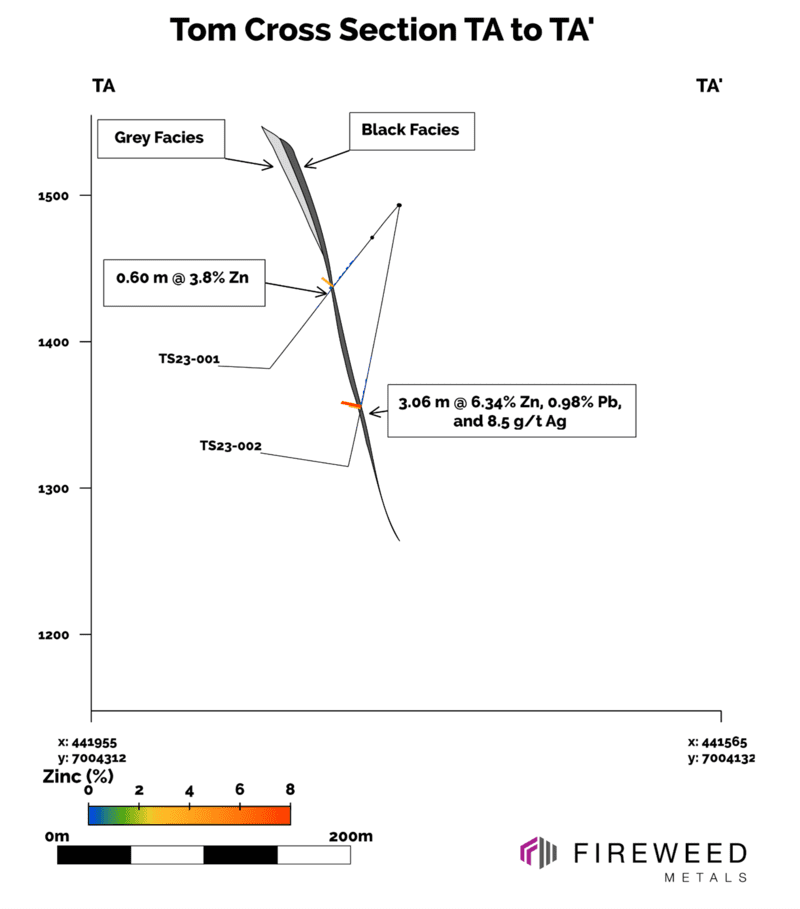
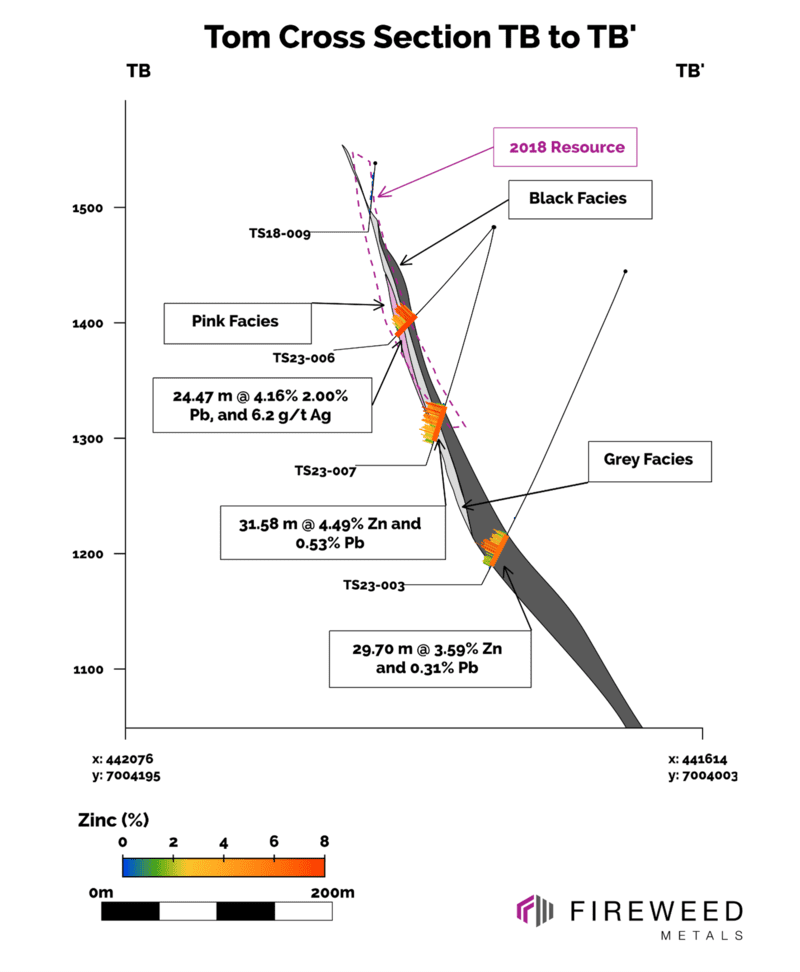


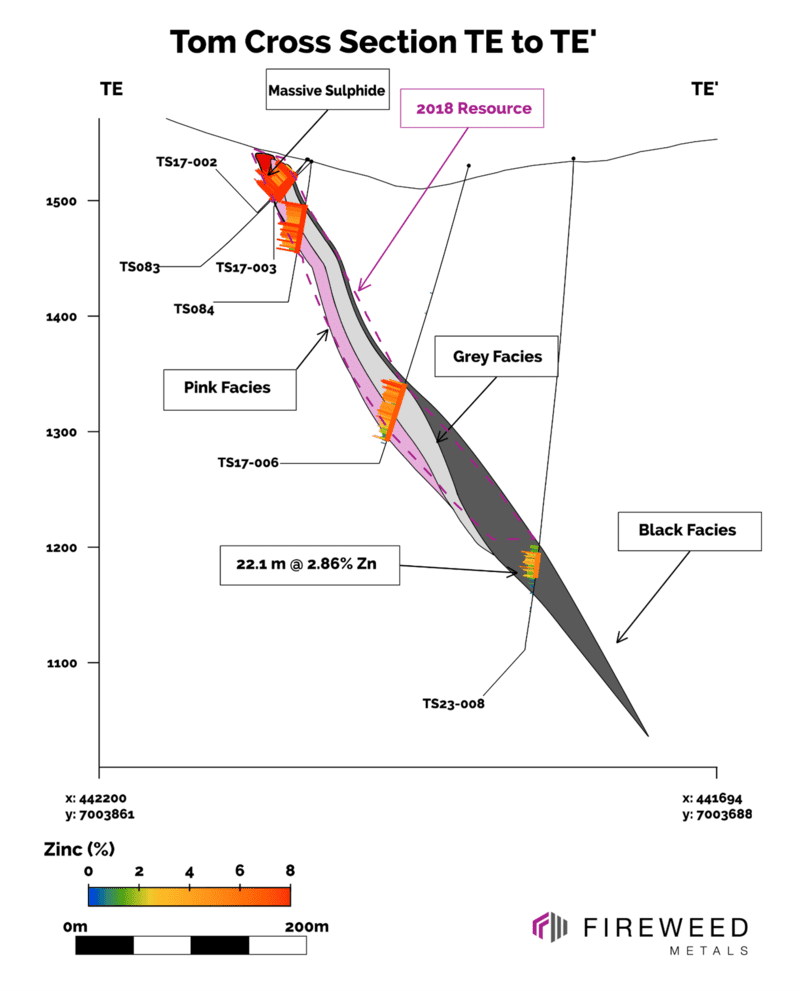

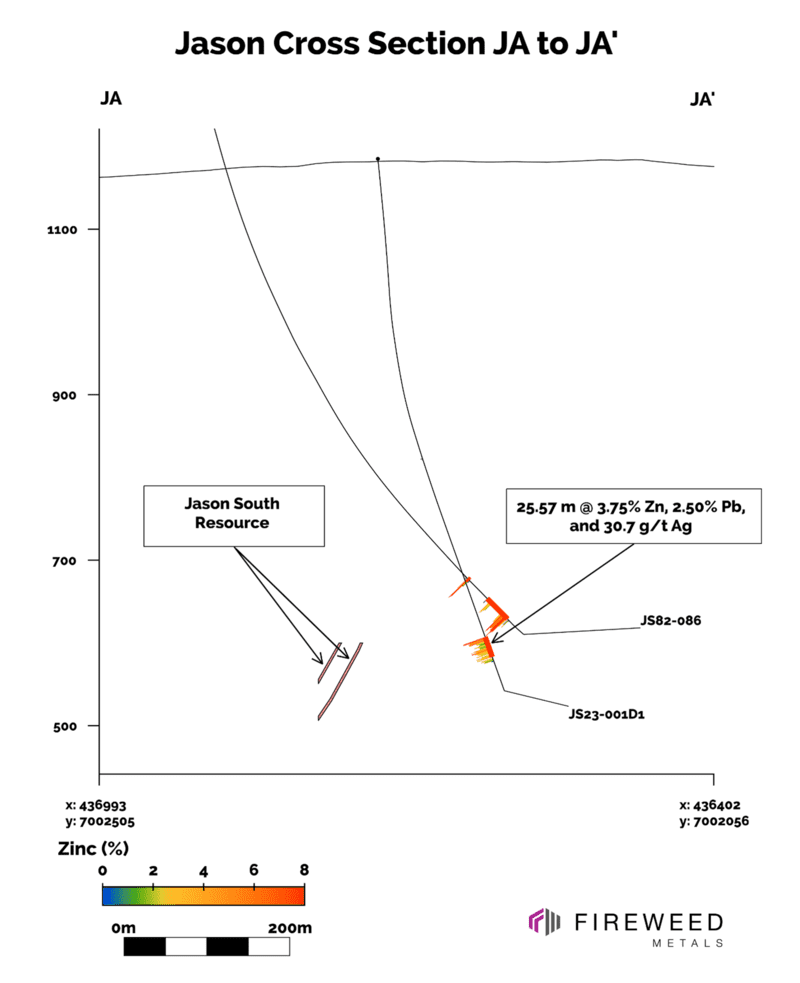

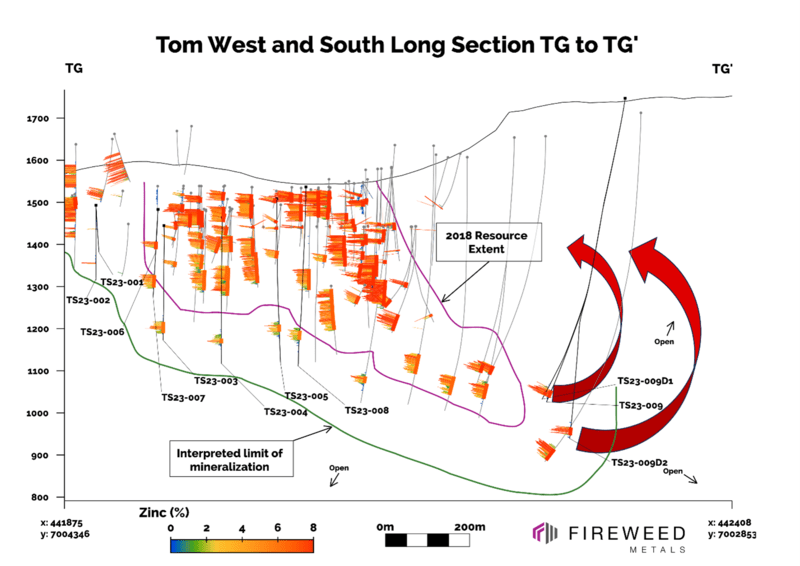
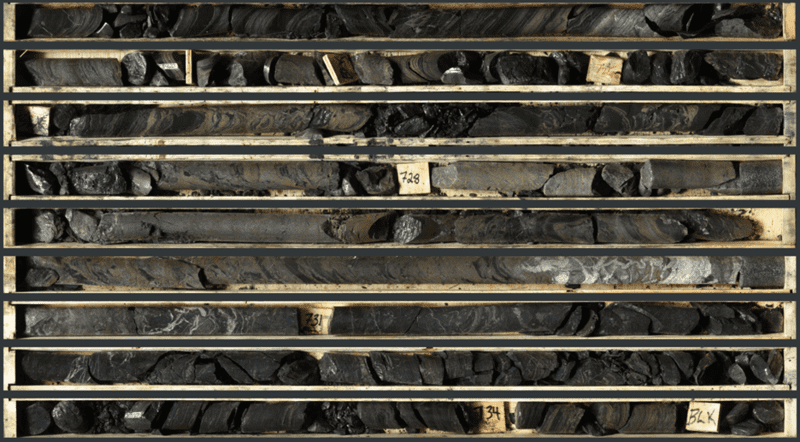
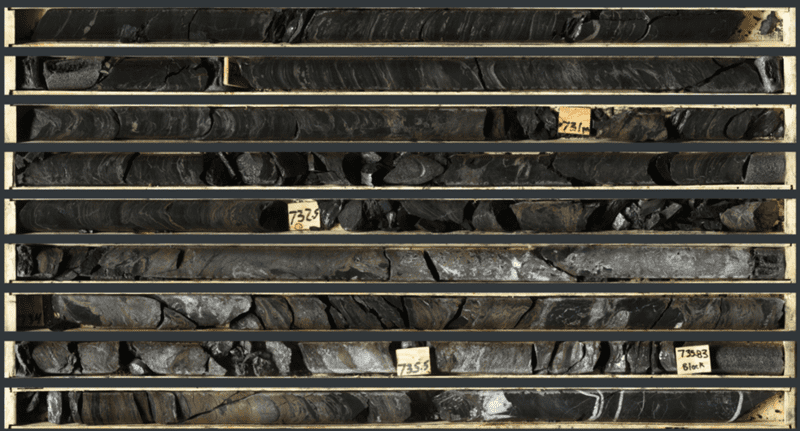
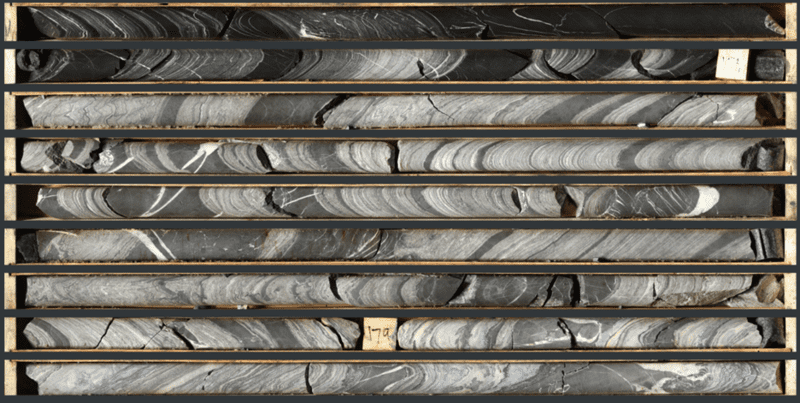
Table 3: TS23-003, TS23-004, TS23-005, TS23-006, TS23-007, TS23-008, TS23-009, TS23-009D1, TS23-009D2, JS23-001, and JS23-001D1 drill results
| Drillhole | Interval | From (m) | To (m) | Interval Width (m) | Est. True Width (m) ‡ | Zinc (%) | Lead (%) | Silver (g/t) | Bulk Density (t/m3) |
| JS23-001D1 | Primary | 595.98 | 621.55 | 25.57 | N/A | 3.75 | 2.50 | 30.7 | 3.13 |
| JS23-001D1 | Including | 595.98 | 612.95 | 16.97 | N/A | 4.18 | 2.98 | 39.3 | 3.16 |
| TS23-003 | Primary | 250.80 | 280.50 | 29.70 | 22 | 3.59 | 0.31 | 1.5 | 2.84 |
| TS23-003 | Including | 261.75 | 271.00 | 9.25 | 6.9 | 6.24 | 0.54 | 1.8 | 2.94 |
| TS23-004 | Primary | 305.74 | 317.50 | 11.76 | 8.7 | 3.33 | 0.32 | 1.5 | 2.84 |
| TS23-005 | Primary | 311.90 | 329.02 | 17.12 | 16 | 3.72 | 0.07 | 1.6 | 2.81 |
| TS23-006 | Primary | 102.00 | 126.47 | 24.47 | 21 | 4.16 | 2.00 | 6.2 | 3.11 |
| TS23-007 | Primary | 161.20 | 192.78 | 31.58 | 19 | 4.49 | 0.53 | 0.9 | 3.21 |
| TS23-008 | Primary | 343.00 | 365.10 | 22.10 | 19 | 2.86 | 0.12 | 1.6 | 2.78 |
| TS23-009 | Primary* | 719.00 | 736.95 | 17.95 | 14 | 11.45 | 5.86 | 126.3 | 3.04 |
| TS23-009 | Including* | 721.30 | 736.95 | 15.65 | 12 | 12.33 | 6.37 | 143.6 | 3.05 |
| TS23-009 | >Including* | 723.60 | 730.20 | 6.60 | 5.1 | 19.33 | 8.42 | 225.1 | 3.23 |
| TS23-009D1 | Primary | 715.74 | 736.44 | 20.70 | 20 | 4.83 | 3.32 | 52.4 | 2.87 |
| TS23-009D1 | Including | 728.61 | 736.44 | 7.83 | 7.7 | 10.63 | 7.08 | 112.2 | 3.08 |
| TS23-009D1 | >Including | 729.61 | 736.44 | 6.83 | 6.7 | 11.70 | 7.89 | 123.7 | 3.12 |
| TS23-009D2 | Primary | 794.20 | 812.98 | 18.78 | 9.8 | 9.82 | 11.65 | 180.1 | 3.39 |
| TS23-009D2 | Including | 796.45 | 811.57 | 15.12 | 7.9 | 10.95 | 13.53 | 211.3 | 3.51 |
| TS23-009D2 | >Including | 799.82 | 811.57 | 11.75 | 6.2 | 11.93 | 16.17 | 260.5 | 3.66 |
‡ See “Data Verification” for a description of true width calculations
Table 4: 2023 Drilling Summary
| Drillhole | Length (m) | Zone | Significant Intersection | Type |
| NB23-001 | 460 | Boundary | Results disclosed Jul 26 2023 | Step Out |
| NB23-002 | 351 | Boundary | Results disclosed Jul 26 2023 | Step Out |
| NB23-003 | 418 | Boundary | Results disclosed Jul 26 2023 | Step Out |
| NB23-004 | 432 | Boundary | Results disclosed Aug 22 2023 | Step Out |
| NB23-005 | 234 | Boundary | Results disclosed Aug 22 2023 | Step Out |
| NB23-006 | 373 | Boundary | Results disclosed Aug 22 2023 | Step Out |
| NB23-007 | 461 | Boundary | Results disclosed Aug 22 2023 | Step Out |
| NB23-008 | 385 | Boundary | Results disclosed Aug 22 2023 | Step Out |
| NB23-009 | 67 | Boundary | Hole abandoned and redrilled as NB23-011 | Step Out |
| NB23-010 | 96 | Boundary | Results disclosed Oct 24 2023 | Step Out |
| NB23-011 | 289 | Boundary | Results disclosed Oct 24 2023 | Step Out |
| NB23-012 | 452 | Boundary | Results disclosed Oct 24 2023 | Step Out |
| NB23-013 | 551 | Boundary | Results disclosed Oct 24 2023 | Step Out |
| NB23-014 | 223 | Boundary | Results disclosed Oct 24 2023 | Step Out |
| NB23-015 | 339 | Boundary | Results disclosed Oct 24 2023 | Step Out |
| NB23-016 | 460 | Boundary | Results disclosed Oct 24 2023 | Step Out |
| NB23-017 | 96 | Boundary | Results disclosed Nov 30 2023 | Step Out |
| NB23-018 | 195 | Boundary | Results disclosed Nov 30 2023 | Step Out |
| NB23-019 | 560 | Boundary | Results disclosed Nov 30 2023 | Step Out |
| NB23-020 | 414 | Boundary | Results disclosed Nov 30 2023 | Step Out |
| NB23-021 | 442 | Boundary | Results disclosed Nov 30 2023 | Infill |
| NB23-022 | 386 | Boundary | Results disclosed Jan 9 2024 | Step Out |
| NB23-022D1 | 448 | Boundary | Results disclosed Jan 9 2024 | Step Out |
| NB23-023 | 181 | Boundary | Results disclosed Nov 30 2023 | Step Out |
| NB23-024 | 402 | Boundary | Results disclosed Nov 30 2023 | Infill |
| NB23-025 | 580 | Boundary | Results disclosed Nov 30 2023 | Step Out |
| NB23-026 | 111 | Boundary | Results disclosed Nov 30 2023 | Step Out |
| NB23-027 | 396 | Boundary | Results disclosed Nov 30 2023 | Infill |
| NB23-028 | 477 | Boundary | Results disclosed Jan 9 2024 | Step Out |
| NB23-029 | 640 | Boundary | Results disclosed Jan 9 2024 | Step Out |
| NB23-029D1 | 689 | Boundary | Results disclosed Jan 9 2024 | Step Out |
| NB23-030 | 526 | Boundary | Results disclosed Nov 30 2023 | Step Out |
| NB23-031 | 574 | Boundary | Results disclosed Jan 9 2024 | Step Out |
| NB23-032 | 495 | Boundary | Results disclosed Jan 9 2024 | Step Out |
| NB23-033 | 681 | Boundary | Results disclosed Jan 22 2024 | Step Out |
| NB23-034 | 580 | Boundary | Results disclosed Jan 22 2024 | Step Out |
| NB23-035 | 552 | Boundary | Results disclosed Jan 22 2024 | Step Out |
| NB23-036 | 397 | Boundary | Results disclosed Jan 22 2024 | Step Out |
| NB23-037 | 544 | Boundary | Results disclosed Jan 22 2024 | Step Out |
| NB23-038 | 427 | Boundary | Results disclosed Jan 22 2024 | Step Out |
| TS23-001 | 143 | Tom North | Results disclosed in this release | Step Out |
| TS23-002 | 182 | Tom North | Results disclosed in this release | Step Out |
| TS23-003 | 299 | Tom West | Results disclosed in this release | Step Out |
| TS23-004 | 369 | Tom West | Results disclosed in this release | Step Out |
| TS23-005 | 407 | Tom West | Results disclosed in this release | Step Out |
| TS23-006 | 137 | Tom West | Results disclosed in this release | Step Out |
| TS23-007 | 215 | Tom West | Results disclosed in this release | Step Out |
| TS23-008 | 428 | Tom West | Results disclosed in this release | Step Out |
| TS23-009 | 749 | Tom South | Results disclosed in this release | Step Out |
| TS23-009D1 | 747 | Tom South | Results disclosed in this release | Redrill |
| TS23-009D2 | 821 | Tom South | Results disclosed in this release | Step Out |
| JS23-001 | 631 | Jason South | Results disclosed in this release | Step Out |
| JS23-001D1 | 665 | Jason South | Results disclosed in this release | Step Out |
| BX23-001 | 219 | Boundary South | No significant mineralization | Exploration |
| BX23-002 | 144 | Boundary South | No significant mineralization | Exploration |
| KB23-001 | 368 | Kobuk | No significant mineralization | Exploration |
| KB23-002 | 284 | Kobuk | No significant mineralization | Exploration |
Table 5: Drill Hole Collar Information
| Drillhole | Zone | Length (m) | Easting | Northing | Elevation (m.s.l) | Azimuth (°) | Dip (°) |
| NB23-001 | Boundary | 460 | 422297 | 7010471 | 1185.86 | 211.99 | -76.42 |
| NB23-002 | Boundary | 351 | 422235 | 7010525 | 1194.57 | 214.06 | -70.22 |
| NB23-003 | Boundary | 418 | 422235 | 7010525 | 1194.57 | 213.40 | -78.00 |
| NB23-004 | Boundary | 432 | 422171 | 7010556 | 1203.00 | 213.91 | -78.08 |
| NB23-005 | Boundary | 234 | 422058 | 7010589 | 1207.95 | 199.63 | -49.74 |
| NB23-006 | Boundary | 373 | 422171 | 7010556 | 1203.00 | 215.44 | -70.02 |
| NB23-007 | Boundary | 461 | 422058 | 7010589 | 1207.95 | 206.37 | -86.43 |
| NB23-008 | Boundary | 385 | 422171 | 7010556 | 1203.00 | 215.83 | -60.07 |
| NB23-009 | Boundary | 67 | 422058 | 7010589 | 1208.67 | 198.54 | -75.41 |
| NB23-010 | Boundary | 96 | 422241 | 7010385 | 1150.41 | 212.28 | -45.00 |
| NB23-011 | Boundary | 289 | 422058 | 7010589 | 1208.67 | 201.59 | -75.40 |
| NB23-012 | Boundary | 452 | 422289 | 7010534 | 1200.90 | 211.75 | -69.90 |
| NB23-013 | Boundary | 551 | 422072 | 7010666 | 1233.59 | 214.94 | -77.68 |
| NB23-014 | Boundary | 223 | 422241 | 7010384 | 1150.86 | 213.68 | -70.83 |
| NB23-015 | Boundary | 339 | 422241 | 7010385 | 1150.41 | 213.36 | -84.00 |
| NB23-016 | Boundary | 461 | 422274 | 7010600 | 1216. 70 | 209.88 | -72.96 |
| NB23-017 | Boundary | 96 | 422279 | 7010359 | 1142.67 | 191.27 | -46.90 |
| NB23-018 | Boundary | 195 | 422279 | 7010359 | 1142.67 | 190.21 | -65.21 |
| NB23-019 | Boundary | 561 | 422289 | 7010534 | 1200.90 | 209.95 | -81.31 |
| NB23-020 | Boundary | 414 | 422465 | 7010510 | 1191.44 | 204.85 | -63.35 |
| NB23-021 | Boundary | 442 | 422391 | 7010500 | 1190.07 | 201.97 | -77.01 |
| NB23-022 | Boundary | 386 | 421948 | 7010672 | 1232.44 | 178.85 | -74.18 |
| NB23-022D1 | Boundary | 448 | 421948 | 7010672 | 1232.44 | 177.78 | -74.00 |
| NB23-023 | Boundary | 181 | 422449 | 7010351 | 1145.42 | 211.82 | -49.18 |
| NB23-024 | Boundary | 405 | 422348 | 7010550 | 1203.82 | 199.65 | -50.18 |
| NB23-025 | Boundary | 582 | 422343 | 7010620 | 1219.03 | 196.94 | -74.05 |
| NB23-026 | Boundary | 111 | 422449 | 7010351 | 1145.42 | 210.02 | -65.44 |
| NB23-027 | Boundary | 451 | 422348 | 7010550 | 1203.82 | 197.18 | -72.46 |
| NB23-028 | Boundary | 467 | 422222 | 7010587 | 1209.75 | 211.38 | -65.44 |
| NB23-029 | Boundary | 630 | 422124 | 7010731 | 1250.31 | 196.21 | -75.67 |
| NB23-029D1 | Boundary | 690 | 422124 | 7010731 | 1250.31 | 196.21 | -75.67 |
| NB23-030 | Boundary | 526 | 422535 | 7010614 | 1214.65 | 211.44 | -62.01 |
| NB23-031 | Boundary | 574 | 422329 | 7010671 | 1235.88 | 207.69 | -69.87 |
| NB23-032 | Boundary | 493 | 422165 | 7010640 | 1224.09 | 210.08 | -62.01 |
| NB23-033 | Boundary | 681 | 422228 | 7010663 | 1233.01 | 211.31 | -73.88 |
| NB23-034 | Boundary | 580 | 422138 | 7010674 | 1237.24 | 199.07 | -72.40 |
| NB23-035 | Boundary | 552 | 422228 | 7010663 | 1232.97 | 199.00 | -72.02 |
| NB23-036 | Boundary | 398 | 422289 | 7010534 | 1200.89 | 212.26 | -59.46 |
| NB23-037 | Boundary | 544 | 422228 | 7010663 | 1232.94 | 204.73 | -66.10 |
| NB23-038 | Boundary | 427 | 422001 | 7010675 | 1233.60 | 179.75 | -68.10 |
| TS23-001 | Tom North | 143 | 441761 | 7004226 | 1492.16 | 075.08 | -49.66 |
| TS23-002 | Tom North | 182 | 441761 | 7004226 | 1492.16 | 074.97 | -80.38 |
| TS23-003 | Tom West | 299 | 441676 | 7004024 | 1445.00 | 074.17 | -68.51 |
| TS23-004 | Tom West | 369 | 441694 | 7003884 | 1463.34 | 067.38 | -71.48 |
| TS23-005 | Tom West | 407 | 441761 | 7003770 | 1510.00 | 063.25 | -75.35 |
| TS23-006 | Tom West | 137 | 441779 | 7004076 | 1485.36 | 065.15 | -50.08 |
| TS23-007 | Tom West | 215 | 441779 | 7004076 | 1485.36 | 065.23 | -78.04 |
| TS23-008 | Tom West | 428 | 441816 | 7003717 | 1538.00 | 089.53 | -88.95 |
| TS23-009 | Tom South | 749 | 442363 | 7003106 | 1747.29 | 351.97 | -82.00 |
| TS23-009D1 | Tom South | 748 | 442363 | 7003106 | 1747.29 | 351.97 | -82.00 |
| TS23-009D2 | Tom South | 821 | 442363 | 7003106 | 1747.29 | 351.97 | -82.00 |
| JS23-001 | Jason South | 631 | 436722 | 7002304 | 1185.00 | 228.15 | -83.90 |
| JS23-001D1 | Jason South | 665 | 436722 | 7002304 | 1185.00 | 228.15 | -83.90 |
| BX23-001 | Boundary Expl. | 219 | 421752 | 7010127 | 1114.70 | 035.16 | -50.19 |
| BX23-002 | Boundary Expl. | 144 | 421637 | 7010243 | 1137.50 | 014.78 | -49.83 |
| KB23-001 | Kobuk | 368 | 418651 | 7012138 | 1311.00 | 006.19 | -51.12 |
| KB23-002 | Kobuk | 284 | 418754 | 7011620 | 1225.00 | 006.00 | -65.24 |













